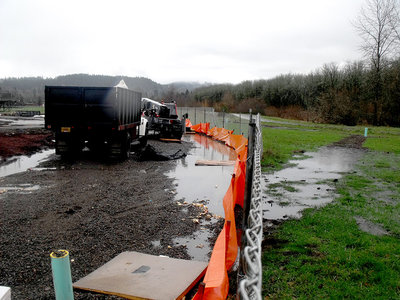
The city of Eugene has cited the $42 million construction project of the future Roosevelt Middle School on East 24th Avenue for failing to prevent stormwater on the site from flowing into the adjacent wetlands of Amazon Creek.
Recent heavy rains have caused rust and diesel-filled water to drain into a grove of trees growing in the wetlands and potentially Amazon Creek, 50 yards from where Hyland Construction is working on the 15-acre site.
A city inspector found that construction crews failed to repair a water containment fence on the creek side of the site, which led to copious amounts of stormwater draining off into the wetlands.
“They should have repaired that fence. They were made aware of it last month, that it needed to be maintained and repaired. They didn’t do that,” says Dal Ollek, an erosion prevention specialist with the city of Eugene, who gave the superintendent at the 15-acre site a correction memo asking them to fix the fence immediately to stop any more flooding.
An 80-foot-wide pond had formed in front of the half-finished building by Dec. 13, and a diesel truck and construction shed were partially situated in the pond. Ollek says the pond has grown so large because the future school, in its half-finished state, has multiple roof and concrete surfaces which can’t absorb the heavy rains of the past weeks, leaving it to collect in the pond below. The soil under the pond is impermeable clay, trapping even more surface stormwater.
Ollek adds that construction sites have many potential chemicals. He says sediments and fuels on these sites can kill the plants and micro-invertebrates in Amazon Creek, which collects much of the stormwater drainage for the city.
“There’s oil and grease and hydraulic fluid that gets into the water also. Generally, it’s pretty nasty stuff, a lot of it. From the rain, it’s a hodgepodge of runoff from those sites,” Ollek says.
Hyland Construction president Shaun Hyland denied any wrongdoing in an interview with EW.
4J Spokesperson Kerry Delf said the construction crews repaired the leaking sediment fence by the morning of Dec. 15. Delf says that the overflowing stormwater does not contain any pollutants from the site.
“We’ll continue to work with our construction crews to try to work to prevent runoff from the site in the future,” she says.
In 2013, the city of Eugene initially rejected the construction plans for the location of the Roosevelt Middle School because the major rebuild was so close to Amazon Creek and its wetlands. The closest edge of the current construction site is about 10 feet from the city-listed wetlands. Several piles of uncovered, rusting rebar are piled against this back border.
Mayor Kitty Piercy says: “There was a lot of concern during the time when they were making the decision about where the new Roosevelt would be. The city expressed some concerns. We didn’t win. My hope is we won’t see a negative impact on the wetland or flooding ruining what Roosevelt Middle School is.”
Multiple diesel trucks, piles of rebar forming rusty red puddles, a littering of cigarette butts, propane tanks, scattered plastic wrapping and old paint buckets were all sitting at the construction site in the rain on Dec. 14.
“There’s a lot of diesel on the ground — mud mixed with grease,” says Lisa Warnes, a volunteer water rights activist with Be Noble, a nonprofit that manages and maintains the Amazon Creek headwaters. She says the polluted water “will eventually leach into the creek. There’s no doubt about it.”
The school district has a stormwater drainage permit with the city for Roosevelt Middle School construction. The general Oregon Department of Environmental Quality (DEQ) stormwater drainage permit requires companies to perform a daily inspection for stormwater overflow during heavy rains.
Warnes says she has consulted a local hydrologist, Al Johnson, to perform water tests on the site for potential chemicals left by Hyland Construction. Long before the Hyland construction, 26 non-native chemicals were found in Amazon Creek in 2013, according to five water samples taken by Oregon Department of Environmental Quality staff. The major chemical was DEET, a mosquito repellent.
Before the recent rains, 50-some community members, including school district staff and teachers, took a tour of the inside of the new middle school on Dec. 5, but news reports did not note the construction.